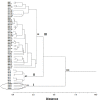Phenotypic characteristics of isolates of Aspergillus section Fumigati from different geographic origins and their relationships with genotypic characteristics
- PMID: 21554728
- PMCID: PMC3115867
- DOI: 10.1186/1471-2334-11-116
Phenotypic characteristics of isolates of Aspergillus section Fumigati from different geographic origins and their relationships with genotypic characteristics
Abstract
Background: Epidemiological studies worldwide have shown that A. fumigatus exhibits important phenotypic and genotypic diversity, and these findings have been of great importance in improving the diagnosis and treatment of diseases caused by this fungus. However, few studies have been carried out related to the epidemiology of this fungus in Latin America. This study's aim is to report on the epidemiology of the fungus by analyzing the phenotypic variability of Aspergillus section Fumigati isolates from different Latin American countries and the relationship between this variability, the geographical origin and genotypic characteristics.
Methods: We analyzed the phenotypic characteristics (macro- and micromorphology, conidial size, vesicles size, antifungal susceptibility and thermotolerance at 28, 37 and 48°C) of A. section Fumigati isolates from Mexico (MX), Argentina (AR), Peru (PE) and France (FR). The results were analyzed using analysis of variance (ANOVA) and Tukey's multiple comparison test to detect significant differences. Two dendrograms among isolates were obtained with UPGMA using the Euclidean distance index. One was drawn for phenotypic data, and the other for phenotypic and genotypic data. A PCoA was done for shown isolates in a space of reduced dimensionality. In order to determine the degree of association between the phenotypic and genotypic characteristics AFLP, we calculated the correlation between parwise Euclidean distance matrices of both data sets with the nonparametric Mantel test.
Results: No variability was found in the macromorphology of the studied isolates; however, the micromorphology and growth rate showed that the PE isolates grew at a faster rate and exhibited the widest vesicles in comparison to the isolates from MX, AR and FR. The dendrogram constructed with phenotypic data showed three distinct groups. The group I and II were formed with isolates from PE and FR, respectively, while group III was formed with isolates from MX and AR. The dendrogram with phenotypic and genotypic data showed the same cluster, except for an isolate from FR that formed a separate cluster. This cluster was confirmed using PCoA. The correlation between the phenotypic and genotypic data of the isolates revealed a statistically significant association between these characteristics.
Conclusions: The PE isolates showed specific phenotypic characteristics that clearly differentiate them from the rest of the isolates, which matches the genotypic data. The correlation between the phenotypic and genotypic characteristics showed a statistically significant association. In conclusion, phenotypic and genotypic methods together increase the power of correlation between isolates.
Figures




Similar articles
-
Phenotypic and genotypic characterization of Aspergillus lentulus and Aspergillus fumigatus isolates in a patient with probable invasive aspergillosis.J Med Microbiol. 2009 Mar;58(Pt 3):391-395. doi: 10.1099/jmm.0.005942-0. J Med Microbiol. 2009. PMID: 19208894
-
Population structure and diversity of the pathogenic fungus Aspergillus fumigatus isolated from different sources and geographic origins.Mem Inst Oswaldo Cruz. 2009 May;104(3):427-33. doi: 10.1590/s0074-02762009000300005. Mem Inst Oswaldo Cruz. 2009. PMID: 19547867
-
AFLP analysis reveals high genetic diversity but low population structure in Coccidioides posadasii isolates from Mexico and Argentina.BMC Infect Dis. 2013 Sep 3;13:411. doi: 10.1186/1471-2334-13-411. BMC Infect Dis. 2013. PMID: 24004977 Free PMC article.
-
[Causative Agents of Aspergillosis Including Cryptic Aspergillus Species and A. fumigatus].Med Mycol J. 2016;57(4):J149-J154. doi: 10.3314/mmj.16.005. Med Mycol J. 2016. PMID: 27904060 Review. Japanese.
-
Azole-resistance in Aspergillus: proposed nomenclature and breakpoints.Drug Resist Updat. 2009 Dec;12(6):141-7. doi: 10.1016/j.drup.2009.09.002. Epub 2009 Oct 29. Drug Resist Updat. 2009. PMID: 19879181 Review.
Cited by
-
Cultivation-dependent analysis of the microbial diversity associated with the seagrass meadows in Xincun Bay, South China Sea.Ecotoxicology. 2015 Oct;24(7-8):1540-7. doi: 10.1007/s10646-015-1519-4. Epub 2015 Jul 23. Ecotoxicology. 2015. PMID: 26197731
-
Epidemiology of Invasive Fungal Infections in Latin America.Curr Fungal Infect Rep. 2012 Mar;6(1):23-34. doi: 10.1007/s12281-011-0081-7. Epub 2012 Jan 5. Curr Fungal Infect Rep. 2012. PMID: 22363832 Free PMC article.
-
Examination of Genome-Wide Ortholog Variation in Clinical and Environmental Isolates of the Fungal Pathogen Aspergillus fumigatus.mBio. 2022 Aug 30;13(4):e0151922. doi: 10.1128/mbio.01519-22. Epub 2022 Jun 29. mBio. 2022. PMID: 35766381 Free PMC article.
-
Phenotypic and Genotypic Identification of Dermatophytes from Mexico and Central American Countries.J Fungi (Basel). 2023 Apr 11;9(4):462. doi: 10.3390/jof9040462. J Fungi (Basel). 2023. PMID: 37108916 Free PMC article.
-
How Environmental Fungi Cause a Range of Clinical Outcomes in Susceptible Hosts.J Mol Biol. 2019 Jul 26;431(16):2982-3009. doi: 10.1016/j.jmb.2019.05.003. Epub 2019 May 9. J Mol Biol. 2019. PMID: 31078554 Free PMC article. Review.
References
-
- Latgé JP. Aspergillus fumigatus, a saprotrotophic pathogenic fungus. Mycologist. 2003;17:56–61. doi: 10.1017/S0269915X0300209X. - DOI
Publication types
MeSH terms
Substances
LinkOut - more resources
Full Text Sources
Medical
Research Materials

